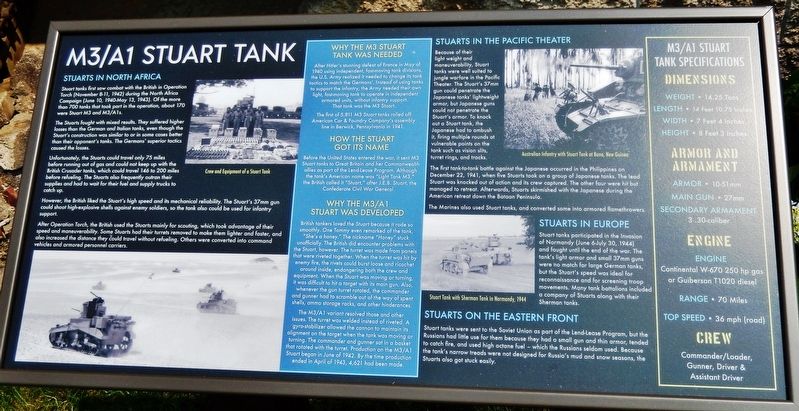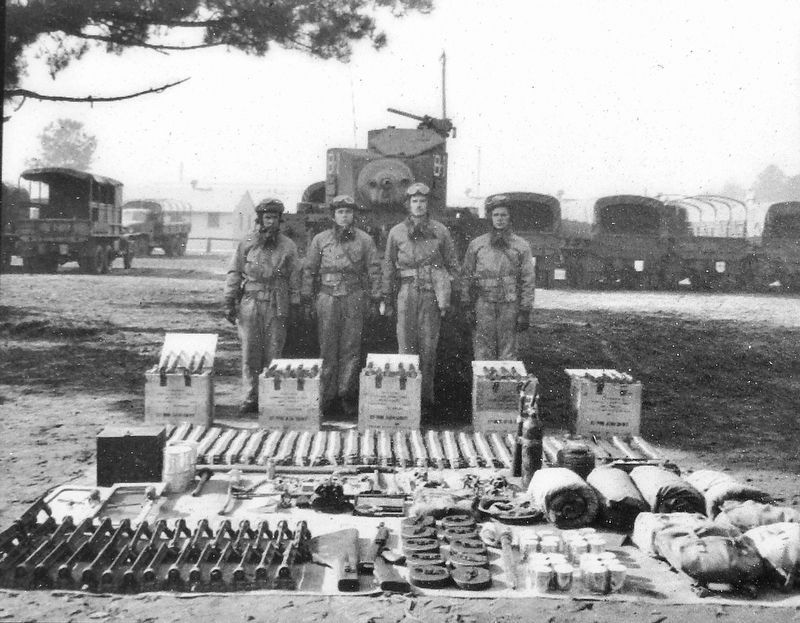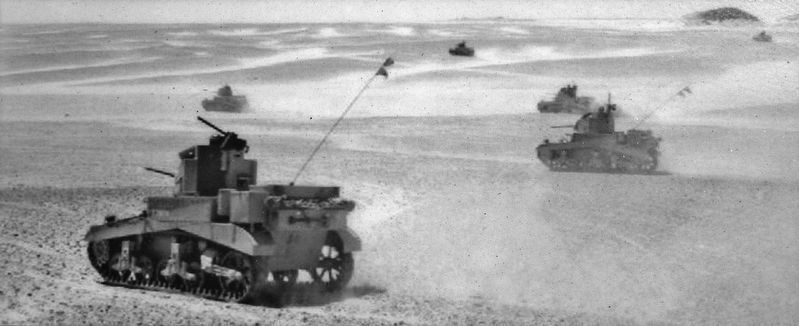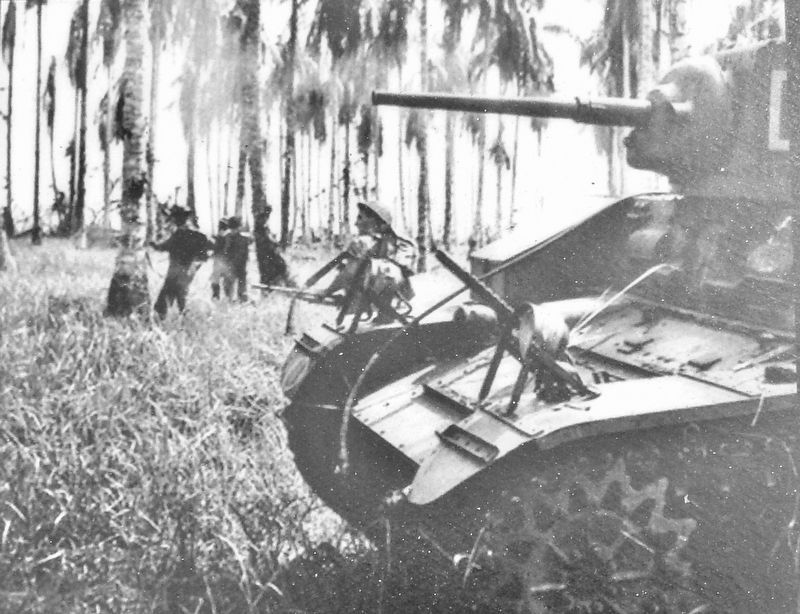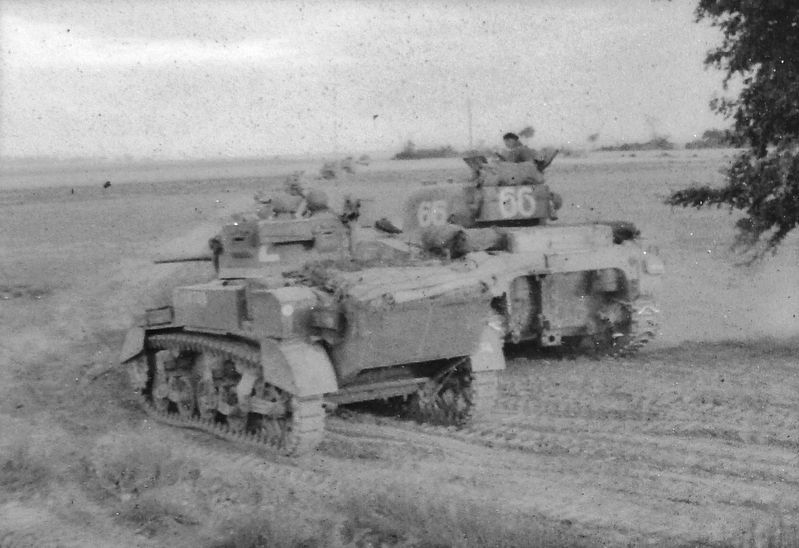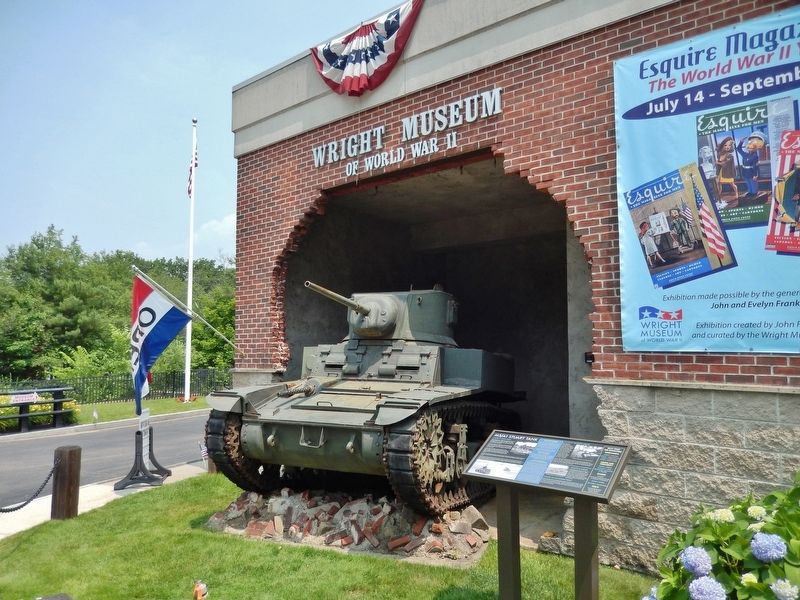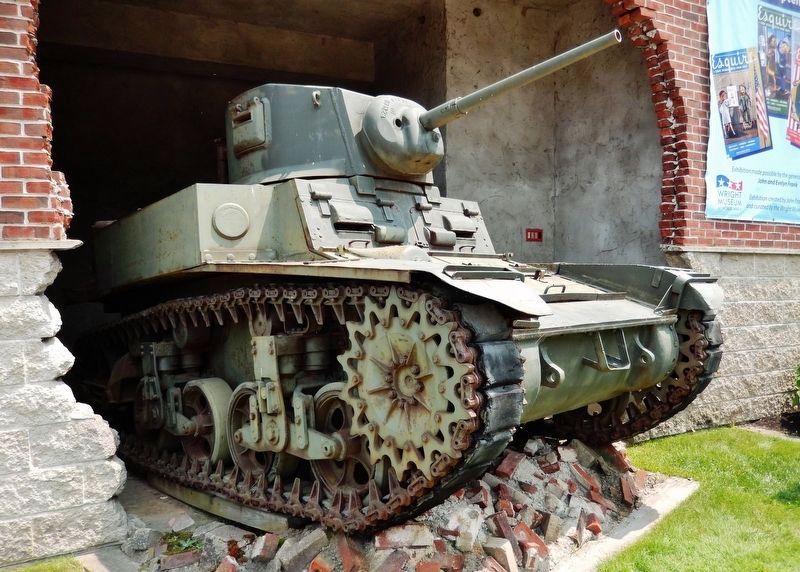Wolfeboro in Carroll County, New Hampshire — The American Northeast (New England)
M3/A1 Stuart Tank
Stuarts in North Africa
Stuart tanks First saw combat with the British in Operation Torch (November 8-11, 1942) during the North Africa Campaign (June 10, 1940-May 13, 1943). Of the more than 700 tanks that took part in the operation, about 170 were Stuart M3 and M3/A1s.
The Stuarts fought with mixed results. They suffered higher losses than the German and Italian tanks, even though the Stuart's construction was similar to or in some cases better than their opponent's tanks. The Germans' superior tactics caused the losses.
Unfortunately, the Stuarts could travel only 75 miles before running out of gas and could not keep up with the British Crusader tanks, which could travel 146 to 200 miles before refueling. The Stuarts also frequently outran their supplies and had to wait for their fuel and supply trucks to catch up.
However, the British liked the Stuart's high speed and its mechanical reliability. The Stuart's 37mm gun could shoot high-explosive shells against enemy soldiers, so the tank also could be used for infantry support.
After Operation Torch, the British used the Stuarts mainly for scouting, which took advantage of their speed and maneuverability. Some Stuarts had their turrets removed to make them lighter and faster, and also increased the distance they could travel without refueling. Others were converted into command vehicles and armored personnel carriers.
Stuarts in the Pacific Theater
Because of their light weight and maneuverability, Stuart tanks were well suited to jungle warfare in the Pacific Theater. The Stuart's 37mm gun could penetrate the Japanese tanks' lightweight armor, but Japanese guns could not penetrate the Stuart's armor. To knock out a Stuart tank, the Japanese had to ambush it, firing multiple rounds at vulnerable points on the tank such as vision slits, turret rings, and tracks.
The first tank-to-tank battle against the Japanese occurred in the Philippines on December 22, 1941, when five Stuarts took on a group of Japanese tanks. The lead Stuart was knocked out of action and its crew captured. The other four were hit but managed to retreat. Afterwards, Stuarts skirmished with the Japanese during the American retreat down the Bataan Peninsula.
The Marines also used Stuart tanks, and converted some into armored flamethrowers.
Stuarts in Europe
Stuart tanks participated in the invasion of Normandy (June 6-July 30, 1944) and fought until the end of the war. The tank's light armor and small 37mm guns were no match for large German tanks, but the Stuart's speed was ideal for reconnaissance and for screening troop movements. Many tank battalions included a company of Stuarts along with their Sherman tanks.
Stuarts on the Eastern Front
Stuart tanks were sent to the Soviet Union as part of the Lend-Lease Program, but the Russians had little use for them because they had a small gun and thin armor, tended to catch fire, and used high octane fuel - which the Russians seldom used. Because the tank's narrow treads were not designed for Russia's mud and snow seasons, the Stuarts also got stuck easily.
Why the M3 Stuart Tank was Needed
After Hitler's stunning defeat of France in May of 1940 using independent, fast-moving tank divisions, the U.S. Army realized it needed to change its tank tactics to match the Germans'. Instead of using tanks to support the infantry, the Army needed their own light, fast-moving tank to operate in independent armored units, without infantry support. That tank was the M3 Stuart.
The first of 5,811 M3 Stuart tanks rolled off American Car & Foundry Company's assembly line in Berwick, Pennsylvania in 1941.
How the Stuart got its Name
Before the United States entered the war, it sent M3 Stuart tanks to Great Britain and her Commonwealth allies as part of the Lend-Lease Program. Although the tank's American name was "Light Tank M3," the British called it "Stuart," after J.E.B. Stuart, the Confederate Civil War General.
Why the M3/A1 Stuart was Developed
British tankers loved the Stuart because it rode so smoothly. One Tommy even remarked of the tank, "She's a honey." The nickname "Honey" stuck unofficially. The British did encounter problems with the Stuart, however. The turret was made from panels that were riveted together. When the turret was hit by enemy fire, the rivets could burst loose and ricochet around inside, endangering both the crew and equipment. When the Stuart was moving or turning, it was difficult to hit a target with its main gun. Also, whenever the gun turret rotated, the commander and gunner had to scramble out of the way of spent shells, ammo storage racks, and other hindrances.
The M3/A1 variant resolved those and other issues. The turret was welded instead of riveted. A gyro-stabilizer allowed the cannon to maintain its alignment on the target when the tank was moving or turning. The commander and gunner sat in a basket that rotated with the turret. Production on the M3/A1 Stuart began in June of 1942. By the time production ended in April of 1943, 4,621 had been made.
Dimensions
Weight • 14.25 Tons
Length • 14 Feet 10.75 Inches
Width • 7 Feet 4 Inches
Height • 8 Feet 3 Inches
Armor and Armament
Armor • 10-51mm
Main Gun • 27mm
Secondary Armament 3 .30-caliber
Engine
Continental W-670 250 hp gas or Guiberson T1020 diesel
Range • 70 Miles
Top Speed • 36 mph (road)
Crew
Commander/Loader, Gunner, Driver & Assistant Driver
Topics. This historical marker is listed in these topic lists: Roads & Vehicles • War, World II. A significant historical date for this entry is November 8, 1942.
Location. 43° 35.354′ N, 71° 12.325′ W. Marker is in Wolfeboro, New Hampshire, in Carroll County. Marker is on Center Street just north of Willow Street, on the right when traveling north. Marker is located beside the sidewalk, near the northwest corner of the Wright Museum of World War II. Touch for map. Marker is at or near this postal address: 77 Center Street, Wolfeboro NH 03894, United States of America. Touch for directions.
Other nearby markers. At least 8 other markers are within 10 miles of this marker, measured as the crow flies. Wolfeboro Falls Railroad Station (within shouting distance of this marker); The Loyal Men of Wolfeboro (approx. 0.4 miles away); College Road (approx. 3.2 miles away); Abenaki Tower (approx. 7.1 miles away); Alton Bay Transportation Center (approx. 8.2 miles away); The Grave By The Lake (approx. 8˝ miles away); Alton New Hampshire Civil War Memorial (approx. 9.2 miles away); Alton New Hampshire Viet Nam Conflict Honor Roll (approx. 9.2 miles away). Touch for a list and map of all markers in Wolfeboro.
Also see . . .
1. M3/A1 Stuart Tank. Although poorly suited to tank warfare in Europe, the Stuart tank proved effective in the Pacific. In New Guinea and the Solomons, the Stuart served in an infantry support role. Although the 37mm gun was not ideal, the small Stuart was much more practical for jungle warfare than the much larger and heavier Sherman that replaced it in late 1943. (Submitted on June 29, 2020, by Cosmos Mariner of Cape Canaveral, Florida.)
2. M3 Stuart (Wikipedia). After the war, some countries chose to equip their armies with cheap and reliable war surplus Stuarts. The Chinese Nationalist Army having suffered great attrition as a result of the ensuing civil war, rebuilt their armored forces by acquiring surplus vehicles left behind in the Philippines by the U.S. forces. (Submitted on June 29, 2020, by Cosmos Mariner of Cape Canaveral, Florida.)
3. M3/A1 Stuart - Usage in battles. Due to its light armour it is advisable not to use the M3/A1 frontally at closer ranges, especially not against higher ranked enemy vehicles that will go through your strongest frontal armour (50.8 mm) without issue. The ideal tactic to use is to employ your competitive speed to flank the enemy and find a position that will allow you to attack them with little resistance. Even in a match against higher ranked enemy vehicles your rounds will have no issue going through the side armour of said enemy vehicles. (Submitted on June 29, 2020, by Cosmos Mariner of Cape Canaveral, Florida.)
Credits. This page was last revised on June 29, 2020. It was originally submitted on June 29, 2020, by Cosmos Mariner of Cape Canaveral, Florida. This page has been viewed 447 times since then and 38 times this year. Photos: 1, 2, 3, 4, 5, 6, 7. submitted on June 29, 2020, by Cosmos Mariner of Cape Canaveral, Florida.
